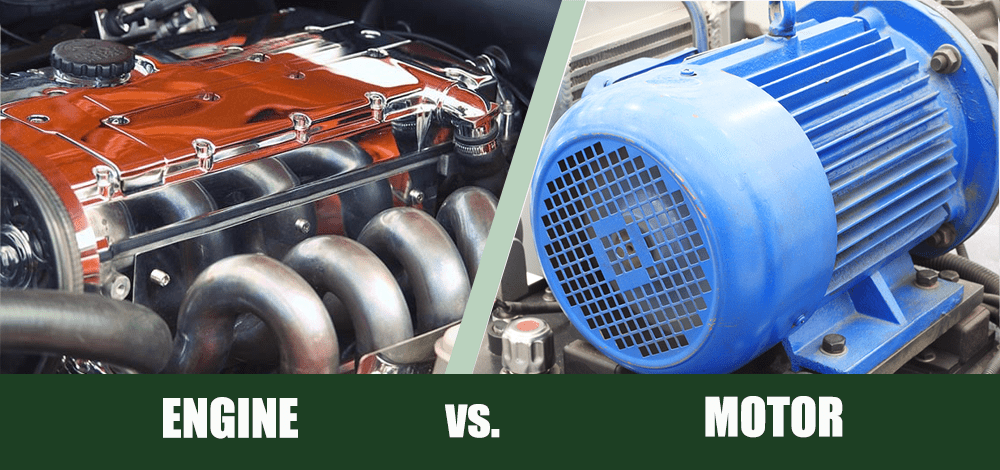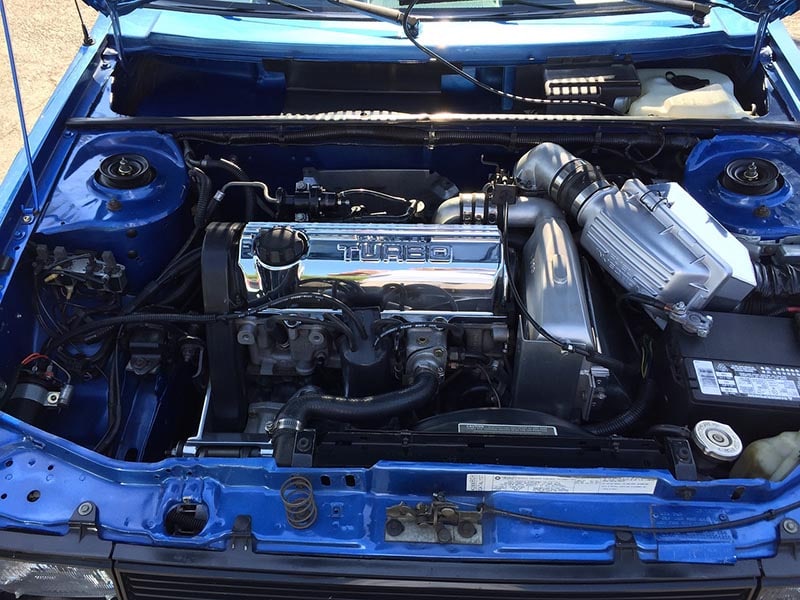Engine vs. Motor: Is There A Difference?
-
Pete Ortiz
- Last updated:

The terms engine and motor are often used interchangeably, and both are used to power a vehicle or other type of machinery. However, there is a key difference between the two: while an engine uses combustion as its power source, a motor uses electricity. So, while both an engine and a motor create mechanical motion, they use different methods to achieve this motion.
An electric car uses a motor while a petrol or diesel car uses an engine. Combustion engines are considered less efficient than electric motors, which also have better initial torque and offer greater acceleration than combustion engines. And, because the two use different types of energy, they also have very different components.
Below, we look in more detail at the differences and similarities between these two devices.
Overview of Engines:

Engines, or combustion engines, are mechanical devices that turn energy from fuel and air into mechanical power. They are most commonly used in transport and engines are found in most cars, vans, ships, buses, and planes.
How Do Engines Work?
Fuel is ignited in a combustion chamber which applies force to some parts of the engine. In car engines, the combustion powers pistons, but other engines may have blades, rotors, or nozzles. Waste gases, or emissions, are created during the process, and a combustion engine features some method of removing or venting these gases.
Types of Engine
There are many ways to classify engine types including:
- Internal vs. External Combustion Engines – The internal combustion engine is the most common type of combustion engine in use today. The combustion process takes place inside the engine, within a combustion chamber. An external combustion engine has an external combustion chamber. Fuel is ignited and the combustion is used to power the engine. Steam engines are a common type of external combustion engine. The combustion creates steam, which then pushes a piston.
- Fuel Type – Another way to classify engine types is the type of fuel used during the combustion process. Petrol, diesel, and gas engines are common.
-
Number of Strokes – Most modern combustion engines are four-stroke engines. In this type of engine, the crankshaft completes two full revolutions. The four strokes are intake, compression, power, and exhaust. These emit lower emissions than two-stroke engines.
In a two-stroke engine, the crankshaft only completes a single revolution with an upstroke and downstroke. Suction and compression take place during the upstroke with expansion and exhaust occurring during the downstroke. Two-stroke engines are smaller but are noisier and create more harmful emissions. - Number of Cylinders – While scooters and other small vehicles have a single cylinder to do all the work, some tractors and smaller cars have two cylinders. Three-cylinder engines have their cylinders arranged in a line, and engines can have up to 16 cylinders.
- Cylinder Arrangement – Cylinders can be arranged vertically or horizontally. They can also have more complex arrangements including a V or W shape, or even a radial arrangement with all of the cylinders arranged in a circle.
- Cooling Process – Engines naturally create a lot of heat as they use combustion to create mechanical power. The engine, therefore, has to undergo some type of cooling process and engines can be classified according to the cooling technique used. Air and water are the most common cooling methods.

- Less refueling time compared to electric motors
- Lower maintenance costs than electric motors
- Proven technology with a long history
- Readily available
- Produce harmful gases
- High cost of fuel
Overview of Motors:

Whereas combustion engines use a combination of fuel and air to generate power, electric motors use electric power. They typically have an external power source, which is one or a collection of cells that provide an electric current that produces torque in the motor shaft. Although more vehicles are being produced with electric motors, the technology is not yet as commonplace or as mature as that of the combustion engine.
How Do Motors Work?
A motor uses electromagnetism to drive a motor shaft. The motor uses opposing and attracting magnetic forces to create rotational motion, and as current is passed from the cells to the motor, it causes the polarisation of the electromagnet to change, therefore spinning the rotor and creating torque in the shaft.
Types of Motor
There are two primary types of electric motors: Direct Current (DC) and Alternating Current (AC) and both have advantages and disadvantages.
- Direct Current – In a DC motor, the magnetic field remains the same but the armature rotates. DC motors have a greater range of speed and motion, and it is easier to control. They can also produce more torque than their AC counterparts. However, they can be less efficient and a little noisier.
- Alternating Current – An AC motor has a rotating magnetic field but the armature remains stationary. This type of motor tends to be quieter but is less efficient and unable to produce as much torque or power as a DC motor.

- Lower emissions than a combustion engine
- Quieter operation
- More torque so better initial acceleration
- Takes longer to refuel/recharge
Pros and Cons of Combustion Engines
When talking about engines versus motors, the conversation is usually centered on their use for powering automobiles. Combustion engines have been used in cars for nearly 150 years. However, fuel-powered combustion engines are seen as being bad for the environment and are, in a lot of countries, being gradually phased out to be replaced by electric cars. Combustion engines still have their benefits, as well as their disadvantages, however.
Pros
- Relatively small size – Most vehicles use internal combustion engines, where the combustion or ignition of the fuel/air mix takes place inside the engine. This configuration takes up comparatively little room when compared to external combustion engines and electric motors. Motors need dozens or more accompanying cells that hold the power that is provided to the motor and these take up a lot of room and weigh a lot.
- Proven technology – The first iteration of what we might consider the modern combustion engine for automobile use was introduced by Karl Benz in 1885. Since then, it has grown in popularity. With more than 60 million cars sold each year worldwide, it is reasonable to assume that 100s of millions, if not billions, of combustion-engine-powered cars have been sold to date. There are more than 100,000 gas stations and more than a quarter of a million auto mechanic businesses in the US alone, so finding fuel and repairs for combustion engines is easier than with electric motors.
- Quick to refuel/recharge – It is possible to refuel a car in as little as 2 minutes. Assuming a full tank of petrol covers 500 miles, this means minimal time to refuel, especially when compared to an electric motor car that can take several hours to fully recharge and that has a much shorter range.
Cons
- Expensive fuel – Fuel and diesel-powered vehicles cost up to three or four times as much per mile than electric cars. This does depend on the efficiency of the cars in question, as well as current electricity and fuel prices, but electric cars work out considerably cheaper per mile than combustion engines.
- Harmful emissions – Fuel cars generate between 8,000–10,000 grams of carbon dioxide from a single gallon of fuel. This equates to approximately 400 grams per mile of driving. This type of engine also creates methane and nitrous oxide, both of which are greenhouse gases and contribute to climate change. Even though modern cars generate fewer emissions than older cars, they still represent a significant proportion of all greenhouse gases from human sources.

Pros and Cons of Electric Motors
With many countries committing to phasing out the sale of petrol and diesel cars within the next 10–20 years, and with a greater onus on environmental protection, more manufacturers are producing cars using electric motors, and more consumers are investing in the technology. As well as the environmental benefits, there are other pros and cons to consider with this type of powertrain.
Pros
- Cheaper to refuel/recharge – It can work out 70% cheaper for the electricity required to drive a single mile in an electric car than it would cost in fuel to drive one with a combustion engine. Although electricity prices have risen, especially as a result of the war in Ukraine, so too have gas and diesel prices.
- Lower initial costs – Although this is not necessarily true of electric cars compared to combustion engine-powered cars, lower-powered electric motors are cheaper to produce than the equivalent combustion engine. As technology improves and more electric motors capable of driving cars become available, the cost of buying electric cars is likely to fall further.
- No harmful emissions – Electric cars have zero tailpipe emissions, which means that they do not produce any harmful emissions while being driven. However, that isn’t to say that they are completely clean. You have to consider the source of the electricity that is used to charge the cells. Well-to-wheel emissions are those that take into account tailpipe emissions and the gases created during the electricity generation process and are generally considered a fairer comparison. All-electric vehicles generate approximately one-third of the well-to-wheel emissions of a traditional, combustion engine.
- Better initial torque – Whereas a combustion engine has to be revved up to reach its peak torque and power, electric motors reach their peak almost instantly. This means that electric motors are more responsive and generate higher levels of torque than their combustion counterparts.
Cons
- Takes longer to refuel/recharge – How long it takes to charge an electric car depends on a lot of factors including its charge level at the beginning of a charge and to what level the batteries are charged. Different cars use different charging techniques and different types of cells, and some charging points use modern fast-charging technology. Typically, it takes around 6 hours to charge a car from empty to full. However, charging times are getting shorter so this may improve in the future.
- Heavier weight requirements – Electric cars are significantly heavier than their combustion engine counterparts. As well as the weight of the motor itself, the cells add a significant amount to the overall weight of the vehicle.

 Conclusion
Conclusion
When looking at the differences between engines and motors, it helps to refer to them as combustion engines and electric motors. Engines are powered by some form of combustible material while motors are powered using electricity. The two have very similar purposes, but they use different methods to achieve those purposes.
Featured Image Credit: Left: Engine (andreas160578, Pixabay) , Right: Motor (ArtisticPhoto, Shutterstock)
Contents


